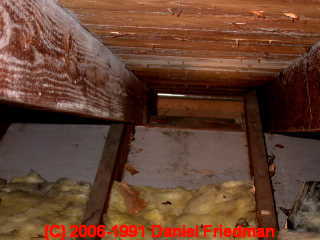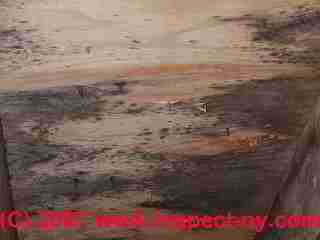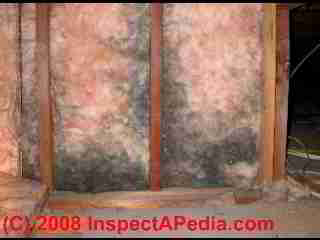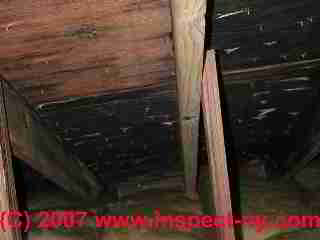 Where to Look For Mold in Attics
Where to Look For Mold in Attics
- POST a QUESTION or COMMENT about exactly where to look for mold contamination in building attics and lofts or cathedral ceilings
Attic mold contamination inspection, where to look: this article explains how and where to inspect or test for mold in building attics and roof cavities.
InspectAPedia tolerates no conflicts of interest. We have no relationship with advertisers, products, or services discussed at this website.
- Daniel Friedman, Publisher/Editor/Author - See WHO ARE WE?
How to find attic mold contamination

This brown mold on plywood roof sheathing visible in an attic is an indicator of wet or damp attic conditions.
It is common to identify Cladosporium sphaerospermum or perhaps Aureobasidium pullulans in these conditions, though without a lab test we don't know what this mold is.
And certainly other mold genera/species may be found in buildng attics. Of the millions of mold genera/species there are about two-hundred, of various colors and various health risks, that are commonly-found in buildings.
[Click to enlarge any image]
The black staining on the plywood roof sheathing visible in this modern attic is a clear indicator of very humid or even wet attic conditions.
When you view the larger copy of this image (click photo for larger image) you may notice that insulation was pushed out into the building eaves where it blocked any intake venting.
This black staining is probably mold.
Though we can't assert that this mold is harmful, we can conclude that the attic has been too wet and that roof venting is not working on this building.
Inspect attic insulation, insulation kraft paper facing, and the attic side of ceiling drywall
visible in
the attic floor, particularly in areas below roof leaks.
It is useful to distinguish between a real roof leak or ice dam leak and more trivial drip stains from attic condensation.
Attic condensation and the resulting drip marks on the attic floor or on attic insulation, as shown here, is not itself likely to wet the attic insulation nor the surfaces below it enough to cause a big mold reservoir.
However, attic condensation is evidence of wet or very humid attic conditions.
Therefore I'd take a close look at the roof sheathing and framing
 If attic insulation has been wet
If attic insulation has been wet
and especially if the insulation has been exposed to other moldy conditions, even
if the insulation itself looks ok it may be mold contaminated.
Some types of building insulation readily harbor mold contamination even if it's not visible (such as fiberglass insulation).
Other types of insulation such as cellulose, seem to resist mold growth (possibly because that material is usually treated with a fire retardant chemical which may also be fungicidal.)
The drip spots you see on attic flooring and insulation
in this photo are from attic condensation which
formed on protruding roof shingle nails in the attic where it formed frost in cold weather, then melted
and dripped onto the attic floor.
This indicates poor attic venting and possibly humid conditions.
But there probably was not enough leakage to cause a mold infection of the insulation or drywall below.
Spot checks for visible mold in the most-likely or most-dripped-on area may be all that's needed.
Look for mold around roof leak areas
& water stains in the attic: at the eaves where shingles are more worn or where ice dam
leaks may occur in freezing weather, at roof penetrations for chimneys and
plumbing vents
 Attic or Under-roof Condensation Drip Marks: Some "leak stains" you may see on the attic floor or on insulation are
not really due to leaks from above. You may be looking at more trivial drip stains from attic condensation.
Attic or Under-roof Condensation Drip Marks: Some "leak stains" you may see on the attic floor or on insulation are
not really due to leaks from above. You may be looking at more trivial drip stains from attic condensation.
Attic condensation
and the resulting
drip marks on the attic floor or on attic insulation, as shown here, is not itself likely to wet the attic
insulation nor the surfaces below it enough to cause a big mold reservoir. However, attic condensation is evidence
of wet or very humid attic conditions.
Therefore take a close look at the roof sheathing and framing in an attic that has been moist or humid even if there have been no roof leaks.
The mold shown in the attic photographed here was identified as Aspergillus sp. on attic mold visible on pine tongue and groove roof sheathing near the building eaves. Also notice the condensation stains at the shingle nail, more evidence of a history of attic moisture which was a factor in this mold growth. (Click photo for larger image).
This article is part of our series:
MOLD in BUILDINGS which describes how to find mold and test for mold in buildings
For an easy, inexpensive, low-tech but very effective mold testing method
see TEST KIT for DUST, MOLD, PARTICLES: INSTRUCTIONS
Reader Question: what should we do about moldy fiberglass insulation?
 (Sept 7, 2012) Wendy said:
(Sept 7, 2012) Wendy said:
Our 35-year-old house has unfaced fiberglass insulation in the attic. It has black mold all over the underside of the fiberglass insulation. How should we take care of it?
Reply:
Watch out: it is easy to mistake harmless black or gray building dust deposition on fiberglass insulation for "mold contamination". Air bypass leaks will leave dark or black marks on fiberglass insulation just like the marks shown on the pink fiberglass insulation in our photo at left.
On the other hand, insulation that has been wet or insulation that has been exposed to high levels of building mold contamination from other sources is at particular risk of mold contamination even if it looks clean.
And kraft or foil-faced fiberglass insulating batts that have been wet may produce mold growth on the paper facing.
See INSULATION STAINS - AIR BYPASS LEAKS and also
see STAINS on INDOOR SURFACES, PHOTO GUIDE
Watch out: for mold-contaminated building insulation in attics (or other building cavities) where there have been leaks or high moisture levels.
See INSULATION MOLD CONTAMINATION TEST
...
Continue reading at ATTIC MOLD, WHAT IT LOOKS LIKE or select a topic from the closely-related articles below, or see the complete ARTICLE INDEX.
Or see these
Recommended Articles
- ATTIC MOLD - home
- ATTIC MOLD CAUSES
- ATTIC MOLD IS A PROBLEM ?
- ATTIC MOLD - IS IT TOXIC?
- ATTIC MOLD, WHERE TO LOOK
- ATTIC MOLD, WHAT IT LOOKS LIKE
- ATTIC MOLD, HARMLESS COSMETIC?
- ATTIC MOLD ROOF TEAROFF
- ATTIC MOLD ENCAPSULANTS
- INSULATION MOLD CONTAMINATION TEST - risk of non-visible problematic mold hidden in building insulation.
Suggested citation for this web page
ATTIC MOLD, WHERE TO LOOK at InspectApedia.com - online encyclopedia of building & environmental inspection, testing, diagnosis, repair, & problem prevention advice.
Or see this
INDEX to RELATED ARTICLES: ARTICLE INDEX to MOLD CONTAMINATION & REMEDIATION
Or use the SEARCH BOX found below to Ask a Question or Search InspectApedia
Ask a Question or Search InspectApedia
Try the search box just below, or if you prefer, post a question or comment in the Comments box below and we will respond promptly.
Search the InspectApedia website
Note: appearance of your Comment below may be delayed: if your comment contains an image, photograph, web link, or text that looks to the software as if it might be a web link, your posting will appear after it has been approved by a moderator. Apologies for the delay.
Only one image can be added per comment but you can post as many comments, and therefore images, as you like.
You will not receive a notification when a response to your question has been posted.
Please bookmark this page to make it easy for you to check back for our response.
IF above you see "Comment Form is loading comments..." then COMMENT BOX - countable.ca / bawkbox.com IS NOT WORKING.
In any case you are welcome to send an email directly to us at InspectApedia.com at editor@inspectApedia.com
We'll reply to you directly. Please help us help you by noting, in your email, the URL of the InspectApedia page where you wanted to comment.
Citations & References
In addition to any citations in the article above, a full list is available on request.
- ENVIRONMENTAL HEALTH & INVESTIGATION BIBLIOGRAPHY - our technical library on indoor air quality inspection, testing, laboratory procedures, forensic microscopy, etc.
- Adkins and Adkins Dictionary of Roman Religion discusses Robigus, the Roman god of crop protection and the legendary progenitor of wheat rust fungus.
- Kansas State University, department of plant pathology, extension plant pathology web page on wheat rust fungus: see http://www.oznet.ksu.edu/path-ext/factSheets/Wheat/Wheat%20Leaf%20Rust.asp
- A BRIEF GUIDE to MOLD, MOISTURE, and YOUR HOME, [PDF] U.S. Environmental Protection Agency US EPA - includes basic advice for building owners, occupants, and mold cleanup operations. See http://www.epa.gov/mold/moldguide.htm
- US EPA - Mold Remediation in Schools and Commercial Building [ copy on file as /sickhouse/EPA_Mold_Remediation_in_Schools.pdf ] - US EPA
- US EPA - UNA BREVA GUIA a MOHO / HONGO - en Espanol
- Atlas of Clinical Fungi, 2nd Ed., GS deHoog, J Guarro, J Gene, & MJ Figueras, Centraalbureau voor Schimmelcultures, Universitat Rovira I Virgili, 2000, ISBN 90-70351-43-9
- A BRIEF GUIDE to MOLD, MOISTURE, and YOUR HOME, [PDF] U.S. Environmental Protection Agency US EPA - includes basic advice for building owners, occupants, and mold cleanup operations. See http://www.epa.gov/mold/moldguide.htm
- "Disease Prevention Program for Certain Vegetable Crops," David B. Langston, Jr., Extension Plant Pathologist - Vegetables, University of Georgia (PDF document) original source: www.reeis.usda.gov/web/crisprojectpages/209797.html
- Disease Prevention in Home Vegetable Gardens [PDF], Patricia Donald,Department of Plant Microbiology and Pathology,
Lewis Jett
Department of Horticulture, University of Missouri Extension - extension.missouri.edu/publications/DisplayPub.aspx?P=G6202 - "Management of Powdery Mildew, Leveillula taurica, in Greenhouse Peppers," Ministry of Agriculture and Lands, British Columbia - Original source: www.agf.gov.bc.ca/cropprot/peppermildew.htm
- Fifth Kingdom, Bryce Kendrick, ISBN13: 9781585100224, - we recommend the CD-ROM version of this book. This 3rd/edition is a compact but comprehensive encyclopedia of all things mycological. Every aspect of the fungi, from aflatoxin to zppspores, with an accessible blend of verve and wit. The 24 chapters are filled with up-to-date information of classification, yeast, lichens, spore dispersal, allergies, ecology, genetics, plant pathology, predatory fungi, biological control, mutualistic symbioses with animals and plants, fungi as food, food spoilage and mycotoxins.
- Fungi, Identifying Filamentous, A Clinical Laboratory Handbook, Guy St-Germain, Richard Summerbell, Star Publishing, 1996, ISBN 0-89863-177-7 (English)
- Mycology, Fundamentals of Diagnostic, Fran Fisher, Norma B. Cook, W.B. Saunders Co. 1998, ISBN 0-7216-5006-6
- US EPA: Una Breva Guia a Moho - Hongo [on file as /sickhouse/EPA_Moho_Guia_sp.pdf - - en Espanol
- In addition to citations & references found in this article, see the research citations given at the end of the related articles found at our suggested
CONTINUE READING or RECOMMENDED ARTICLES.
- Carson, Dunlop & Associates Ltd., 120 Carlton Street Suite 407, Toronto ON M5A 4K2. Tel: (416) 964-9415 1-800-268-7070 Email: info@carsondunlop.com. Alan Carson is a past president of ASHI, the American Society of Home Inspectors.
Thanks to Alan Carson and Bob Dunlop, for permission for InspectAPedia to use text excerpts from The HOME REFERENCE BOOK - the Encyclopedia of Homes and to use illustrations from The ILLUSTRATED HOME .
Carson Dunlop Associates provides extensive home inspection education and report writing material. In gratitude we provide links to tsome Carson Dunlop Associates products and services.


